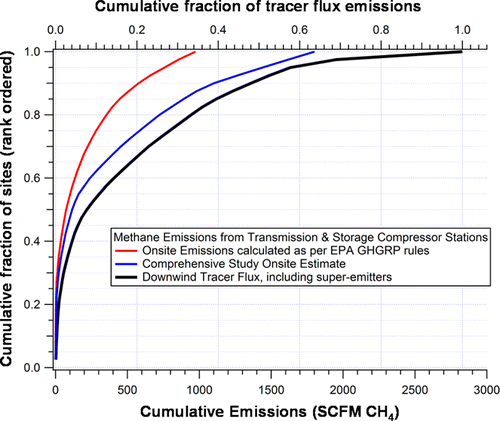Methane emissions from natural gas industry higher than previously thought

World leaders are working to reduce greenhouse gas emissions, but it's unclear just how much we're emitting. In the U.S., the Environmental Protection Agency (EPA) has a new program to track these emissions, but scientists are reporting that it vastly underestimates methane emissions from the growing natural gas industry. Their findings, published in two papers in the ACS journal Environmental Science & Technology, could help the industry clamp down on "superemitter" leaks.
Allen L. Robinson and colleagues note that the primary component of natural gas is methane, a greenhouse gas more potent than carbon dioxide. The EPA estimates that nearly one-quarter of methane emissions related to human activities comes from producing natural gas, processing it and getting it into the homes of millions across the country. But the agency based its estimate on data from 20 years ago. Robinson's team wanted to see if more recent changes in the industry and technology could further refine the numbers.
The researchers discovered that a small fraction of facilities that collect, process and compress natural gas are responsible for a disproportionately high percentage of methane emissions. They also found that the EPA's new reporting program doesn't account for superemitters—sites that leak or vent large amounts of methane—or some equipment and operating modes that are major sources of the gas. They conclude that the program could be missing almost two thirds of the methane emissions from the natural gas system.
More information: Measurements of Methane Emissions from Natural Gas Gathering Facilities and Processing Plants: Measurement Results, Environ. Sci. Technol., Article ASAP. DOI: 10.1021/es5052809
Abstract
Facility-level methane emissions were measured at 114 gathering facilities and 16 processing plants in the United States natural gas system. At gathering facilities, the measured methane emission rates ranged from 0.7 to 700 kg per hour (kg/h) (0.6 to 600 standard cubic feet per minute (scfm)). Normalized emissions (as a % of total methane throughput) were less than 1% for 85 gathering facilities and 19 had normalized emissions less than 0.1%. The range of methane emissions rates for processing plants was 3 to 600 kg/h (3 to 524 scfm), corresponding to normalized methane emissions rates <1% in all cases. The distributions of methane emissions, particularly for gathering facilities, are skewed. For example, 30% of gathering facilities contribute 80% of the total emissions. Normalized emissions rates are negatively correlated with facility throughput. The variation in methane emissions also appears driven by differences between inlet and outlet pressure, as well as venting and leaking equipment. Substantial venting from liquids storage tanks was observed at 20% of gathering facilities. Emissions rates at these facilities were, on average, around four times the rates observed at similar facilities without substantial venting.
Methane Emissions from Natural Gas Compressor Stations in the Transmission and Storage Sector: Measurements and Comparisons with the EPA Greenhouse Gas Reporting Program Protocol, Environ. Sci. Technol., Article ASAP. DOI: 10.1021/es5060258
Abstract
Equipment- and site-level methane emissions from 45 compressor stations in the transmission and storage (T&S) sector of the US natural gas system were measured, including 25 sites required to report under the EPA greenhouse gas reporting program (GHGRP). Direct measurements of fugitive and vented sources were combined with AP-42-based exhaust emission factors (for operating reciprocating engines and turbines) to produce a study onsite estimate. Site-level methane emissions were also concurrently measured with downwind-tracer-flux techniques. At most sites, these two independent estimates agreed within experimental uncertainty. Site-level methane emissions varied from 2–880 SCFM. Compressor vents, leaky isolation valves, reciprocating engine exhaust, and equipment leaks were major sources, and substantial emissions were observed at both operating and standby compressor stations. The site-level methane emission rates were highly skewed; the highest emitting 10% of sites (including two superemitters) contributed 50% of the aggregate methane emissions, while the lowest emitting 50% of sites contributed less than 10% of the aggregate emissions. Excluding the two superemitters, study-average methane emissions from compressor housings and noncompressor sources are comparable to or lower than the corresponding effective emission factors used in the EPA greenhouse gas inventory. If the two superemitters are included in the analysis, then the average emission factors based on this study could exceed the EPA greenhouse gas inventory emission factors, which highlights the potentially important contribution of superemitters to national emissions. However, quantification of their influence requires knowledge of the magnitude and frequency of superemitters across the entire T&S sector. Only 38% of the methane emissions measured by the comprehensive onsite measurements were reportable under the new EPA GHGRP because of a combination of inaccurate emission factors for leakers and exhaust methane, and various exclusions. The bias is even larger if one accounts for the superemitters, which were not captured by the onsite measurements. The magnitude of the bias varied from site to site by site type and operating state. Therefore, while the GHGRP is a valuable new source of emissions information, care must be taken when incorporating these data into emission inventories. The value of the GHGRP can be increased by requiring more direct measurements of emissions (as opposed to using counts and emission factors), eliminating exclusions such as rod-packing vents on pressurized reciprocating compressors in standby mode under Subpart-W, and using more appropriate emission factors for exhaust methane from reciprocating engines under Subpart-C.
Journal information: Environmental Science & Technology
Provided by American Chemical Society













